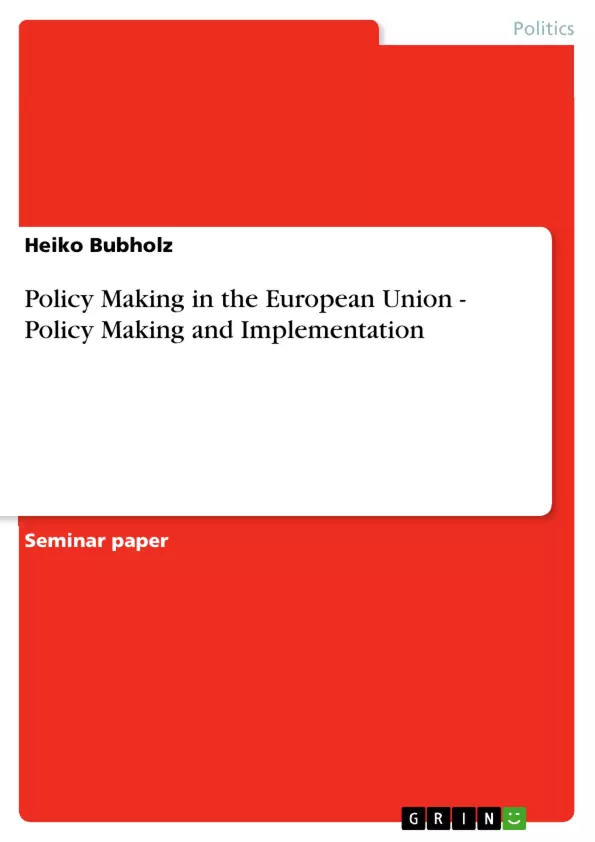Now, in January 2002, a visible step in European integration has been accomplished. With the introduction of the European €-currency about 296,8 millions citizen1 of the European Union (EU) will hold the new symbols of unity of Europe’s peoples in their hands. What began with an attempt of reconciliation and co-operation via the ECSC in 1952 has now developed towards a so far unprecedented transfer of sovereign rights and competence from nation states to a supranational/intergovernmental organisation. However, throughout the EU prevail doubts concerning the deeper mechanism of policy making. Despite certain inscrutability and the mysterious nature of decision making there are demands for more democracy in the Union. On the other side it may be assumed that most of the European citizen do not really take notice of high and low politics decided upon in the European institutions. Aim of this paper shall therefor be a closer elaboration of the policy making process in the European Union, the enforcement of decisions on European and national level, and finally influences or interdependencies from outside the formal institution, interfering in Europe’s policy and polity. Hence, the results of the Nice IGC are not ratified yet – which might not be assumed soon – I focus on the binding regulations of the Amsterdam Treaty2. After a short description of the – as I would prefer to name it – macro level (Commission, Council, Parliament, Courts), where provisions are concluded, the implementation of this policies and decisions on the micro/national level shall be explained thereafter. Finally outside impetus (lobbying, national interests, etc.) on the decision and interpretation process shall be elaborated in a limited scope as well.
[...]
Inhaltsverzeichnis (Table of Contents)
- Introduction
- Policy Making in the European Union
- Legal Foundation of the European Union
- Competence and Limited Power
- Implied Powers
- Primary and Secondary Sources of EU Law
- Regulations
- Directives
- Decisions
- Sui Generis Acts, Soft Law and Case Law
- European Union Institutions
- Commission
- Council
- Parliament
- Court
- Others
- Member States and National Interests
- Interest Groups and Lobbying
- Legal Foundation of the European Union
- Implementation of EU Policy
- Enforcement of EU Law regarding Article 10 TEC
- Enforcement of EU Law regarding Articles 226-228 TEC
- Sanctions
- Non-compliance and Reciprocity
- Conclusion
Zielsetzung und Themenschwerpunkte (Objectives and Key Themes)
This paper aims to provide a comprehensive overview of the policy making process in the European Union. It focuses on the enforcement of decisions on both European and national levels, and explores the influence of external factors on the decision making process. The paper utilizes the Amsterdam Treaty as its framework and examines the roles of the European Union's key institutions, including the Commission, Council, Parliament, and Court.
- The legal foundation of the European Union
- The role of institutions in policy making
- Implementation of EU policies at the national level
- The influence of external factors on EU policy making
- The sui generis nature of the EU
Zusammenfassung der Kapitel (Chapter Summaries)
- Introduction: This chapter sets the stage for the paper, highlighting the significance of the European Union's integration process and its current state. It introduces the main objectives of the paper, focusing on policy making, implementation, and external influences.
- Policy Making in the European Union: This chapter explores the legal foundation of the European Union, examining its constitutional framework and the principles of subsidiarity and limited power. It delves into the primary and secondary sources of EU law, including regulations, directives, and decisions. The chapter then introduces the key institutions of the EU, discussing their roles and responsibilities in the policy making process.
- Implementation of EU Policy: This chapter focuses on the enforcement of EU law at the national level. It analyzes the mechanisms used to ensure compliance with EU regulations, highlighting the importance of Article 10 TEC and Articles 226-228 TEC. The chapter also explores the consequences of non-compliance and the role of reciprocity in the enforcement process.
Schlüsselwörter (Keywords)
The paper primarily focuses on European Union policy making, legal framework, institutions, implementation, national level, enforcement, and external influences. Key concepts include subsidiarity, limited power, sui generis structure, and the Amsterdam Treaty.
- Arbeit zitieren
- Heiko Bubholz (Autor:in), 2002, Policy Making in the European Union - Policy Making and Implementation, München, GRIN Verlag, https://www.grin.com/document/5548



